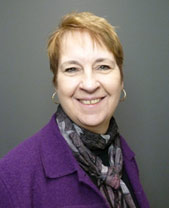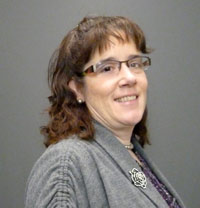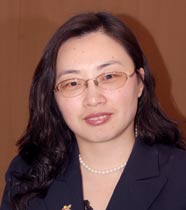Perspectives on the Nursing Home as a Clinical Setting for Different Courses in the Curriculum
The faculty members pictured below share their individual perspective about the best time to integrate clinical experiences into their courses. Click the play button for each to listen.
Mary Zaccagnini, DNP, RN, CNS
Assistant Clinical Professor,
School of Nursing, University of Minnesota

Transcript
Mary Goering, MS, RN, BC,
Clinical Assistant Professor,
School of Nursing, University of Minnesota

Transcript
Leadership and Management Focus in the Nursing Home Clinical Setting
Because I've had previous experience in teaching geriatrics in a long-term care facility, for both beginning and senior nursing students, I'd say there are advantages to teaching at both levels. Of course, the objectives might be different, but each group can have positive experiences, and good outcomes. When the outcome involves an understanding of leadership and managment in long-term care facilities, different approaches could be effective. Either group, for example, could spend time with a charge nurse or with a nurse manager. By following either nurses, the students can observe the various techniques that the nurse uses in delegation and prioritization. For example, when various immediate demands are being placed on the nurse, the students can observe how someone in the leadership role could delegate, and which task or action would be placed at the highest, versus the lowest, priority level. Then this could be turned into an activity by allowing the students to care for a group of residents, which would include the prioritization of tasks, as well as decision-making regarding what activities would be delegated to other staff, such as the CNAs. The students could also be allowed to follow the nurse manager into care conferences, so the students can identify the expanded role of the geriatric nurse, as well as how this plays out in interdisciplinary gatherings, where critical decisions are made. These experiences could be followed by the nurse then interviewing or observing the director or the assistant director of nursing. This would demonstrate not only the various levels of nursing leadership, but also the various roles that are available for nurses who care for the geriatric population. They may also be exposed to the interface between the direct care nurses and those in an administrative role. Finally, it might be worthwhile to have the nurses spend time with a specialized nursing leader within the facility. An example could be an MDS or a wound care nurse. The students would then be able to see how a nurse in this capacity would balance their leadership role with the direct care demands that each would experience within the facility. In all of these experiences, it would be hoped that the students would gain not only the knowledge about how a nurse would function as a leader in geriatric care, but also would gain an appreciation for the role, and some interest in working in long-term care.
Geriatric Nursing Focus in the Nursing Home Clinical Setting
I have taught in a nursing home both as the first clinical course for sophomores and as the geriatric specialty course for seniors. In my view, using a nursing home as a clinical site works for any courses. However, depending on the course objectives and students’ experiences, the instructor needs to think creatively how to best utilize the nursing home resources to maximize student learning.
Nursing home sites work well for a specialty geriatric course because it allows students to apply what they learn in the classroom in practice right away. For example, a week’s topic is on exercise in older adults, focusing on assessing physical activity and exercise levels, developing an exercise program including the mode and doses of different exercise, screening older adults for exercise screening, implementing the exercise program, and evaluating exercise outcomes and program adherence and success. Before the clinical day or during the pre-conference of the clinical day, the instructor can assign students to assess physical and exercise levels of their individual resident, screen the resident for exercise safety, and develop an exercise program by mid-day. The instructor can re-convene a group meeting to discuss each student’s assessment and plan collectively. In the afternoon, the students will actually implement all or part of their plans. During the post-conference, the instructor can facilitate, further discuss the experiences like what worked, what did not work, what could have been done for improving the plan and its implementation, how outcomes should be evaluated, etc.
In subsequent weeks, the instructor can keep reinforcing the plans that have been developed over the previous weeks, so students repeatedly visit the topics of the course. By the end of the semester, students will have developed a comprehensive care plan for their residents based on each week’s clinical practice. Hence, it will be particularly helpful to students if the instructor could use the last one or two clinical experiences to review all topics, so students better understand the complexity of older adult care.
Fundamental Nursing Focus in the Nursing Home Clinical Setting
For the student who is introduced to the nursing home for a first clinical experience, there are a number of advantages. For example, the stability of the client census in a nursing home allows a student to work with the same resident over a number of clinical sessions. This allows the student to gain confidence in therapeutic communication skills, build trust with the resident and gain exposure to the care of the older adult. Also, the nursing home setting is a clinical area where first-time students can gain experience with health assessment and interviewing skills with clients who are medically stable. Although residents in the nursing home are medically stable, there are opportunities for students to learn about the physical needs of the older adult as well as management of chronic illness. In doing so, the student can participate in the provision of activities of daily living, complete ordered nursing assessments and delegated medical treatments, as well as medication administration and appropriate documentation. Students can also utilize evidence-based assessment tools as they gather assessment data from the resident and apply the principles of the nursing process to create an individualized plan of care. Finally, the student can learn about the interdisciplinary team and how the role of the RN is essential in managing the care of the older adult in the nursing home.
